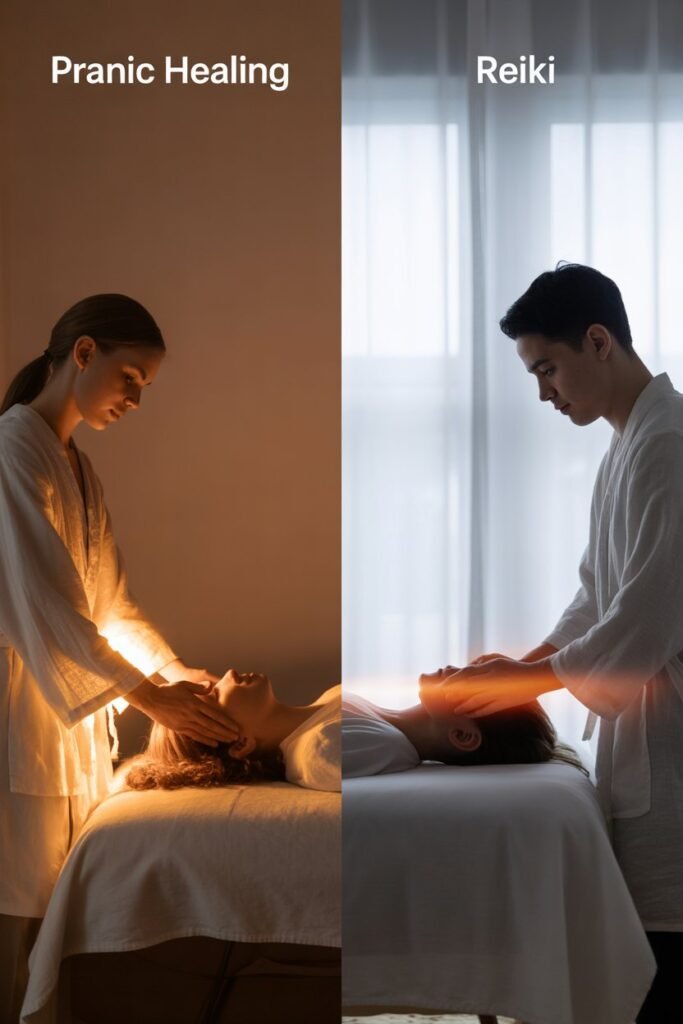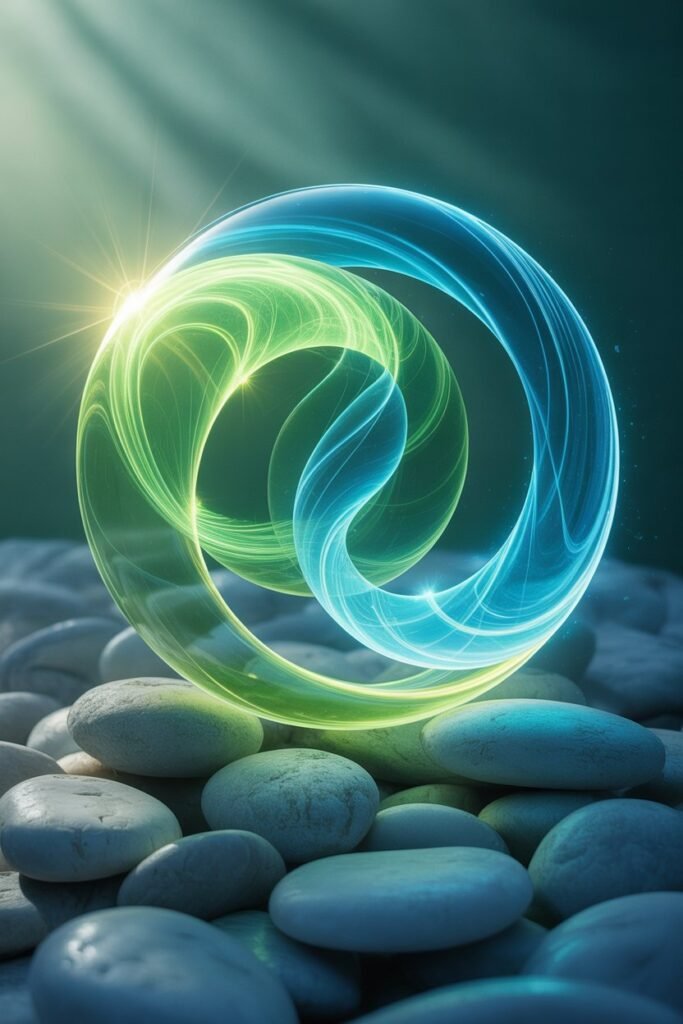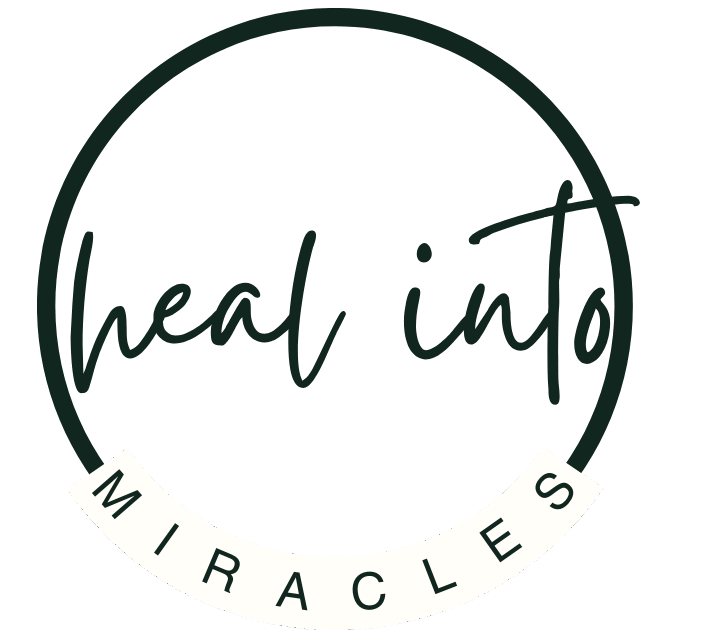Pranic Healing vs. Reiki- 7 Main Differences!
nergy healing has been practiced for centuries, but in recent years, two techniques have gained a lot of attention worldwide: Pranic Healing and Reiki.
Both are rooted in the idea that our bodies are more than just flesh and bones—we are energetic beings, and when that energy gets blocked or imbalanced, we feel it as illness, stress, or emotional pain.
At first glance, Pranic Healing and Reiki may sound similar. After all, both focus on channeling energy for healing. But once you experience or study them, you’ll notice they’re not the same at all.
They have different philosophies, methods, and even limitations.
Let’s dive into the 7 key differences between Pranic Healing and Reiki, explained in detail.
1. Source of Energy
This is the biggest difference between the two.
Reiki: In Reiki, practitioners channel universal life force energy. Think of it as plugging into an endless source of energy that flows through the healer to the receiver. The practitioner is not giving away their personal energy; they’re just the conduit. That’s why Reiki practitioners don’t usually feel drained after a session.

Pranic Healing: Pranic Healing works more directly with the body’s energy. The healer doesn’t “channel” universal energy in the same way as Reiki. Instead, they manipulate and direct prana—your body’s vital energy—using techniques like scanning, cleansing, and energizing. Because the healer’s own energy plays a role, their personal vitality and balance can impact how effective the healing is.
In short: Reiki draws from an external, infinite source, while Pranic Healing relies more on the healer’s skill and energetic strength.
2. Self-Healing
Both systems can be used for self-healing, but there’s a noticeable difference in ease.
Reiki: Reiki is extremely beginner-friendly. You don’t have to be in perfect health or have strong energy yourself. Since you’re drawing from universal energy, you can still practice Reiki on yourself even when you’re sick, tired, or emotionally drained. The energy naturally flows to where it’s needed.
Pranic Healing: Technically, you can perform Pranic Healing on yourself, but it’s harder to do effectively if you’re unwell. Because the practice involves scanning your aura, cleansing, and projecting prana, your own low energy levels can interfere with the process. That’s why many people prefer to go to a skilled Pranic Healer, especially when they’re struggling.
Reiki wins here in terms of accessibility. Even a total beginner can pick it up and start feeling results.
3. General vs. Specific Healing
The scope of healing is another key difference.
Reiki: Reiki is often described as an all-rounder. It doesn’t require diagnosis or pinpointing the problem. You simply place your hands and allow the energy to flow.
Reiki tends to heal holistically addressing physical symptoms, emotional stress, and even spiritual blocks in one go. It’s like pressing a reset button for your whole system.

Pranic Healing: Pranic Healing is more like a surgical approach. The healer scans your energy field to find specific imbalances, then cleanses and energizes those areas.
It’s highly targeted, which means it can work very well on particular conditions or emotional blocks. However, it requires more knowledge and precision.
Reiki spreads energy where it’s most needed, while Pranic Healing focuses on problem areas directly.
4. Learning Curve
Here’s where the practicality comes in.
Reiki: Reiki is simple to learn. Many people take a weekend workshop and walk away able to use it for themselves and others. The system is intuitive and doesn’t require deep technical understanding—you’re essentially opening yourself to be a channel.
Pranic Healing: Pranic Healing, in contrast, has a steeper learning curve. It involves understanding energy anatomy, chakra systems, and specific protocols for cleansing and energizing. It’s more structured and technical, which can make it powerful but not as instantly accessible as Reiki.
If you want to start practicing energy healing quickly, Reiki is the easier entry point.
5. Dependency on Practitioner’s Energy
This is one of the most practical differences.
Reiki: Since Reiki taps into universal energy, the practitioner doesn’t “use up” their own energy. Their personal mood, health, or vitality doesn’t affect the session much.
That’s why even beginner practitioners can still deliver effective Reiki.
Pranic Healing: In Pranic Healing, the healer’s personal energy and skill matter a lot. A practitioner with strong, clear energy will deliver far better results than one who is depleted. This means the effectiveness of a session depends on who is doing it.
Reiki is consistent, but Pranic Healing varies depending on the practitioner.
6. Accessibility
How easy is it to get healing?
Reiki: You can practice Reiki on yourself, learn it quickly, and even receive it remotely (distance Reiki is widely practiced). That makes it highly accessible no matter where you are.

Pranic Healing: To really benefit, you usually need to find a trained practitioner. And not every practitioner is equally effective, since their energy plays a role. This makes it less accessible compared to Reiki.
Reiki is something anyone can use anytime, while Pranic Healing is more dependent on finding the right healer.
7. Emotional & Mental Healing
Both systems can help with emotional wellness, but they work differently.
Reiki: Reiki naturally calms the nervous system, reduces stress, and helps release emotional baggage in a gentle way. Many people report feeling lighter, more peaceful, and more balanced after a Reiki session.
Pranic Healing: This system often takes a more structured approach. Practitioners target specific chakras and remove “dirty” or stagnant energy that causes negative emotions. It can feel more direct but also requires the practitioner’s skill in identifying the problem areas.
Reiki offers a soft, overall emotional release, while Pranic Healing goes in like an energetic detox.
Final Thoughts
Both Pranic Healing and Reiki are powerful tools for healing and self-discovery. Reiki shines because of its simplicity and universal accessibility, you can do it anytime, anywhere, even when you’re not feeling your best.
Pranic Healing, on the other hand, is highly specialized and effective but depends heavily on the healer’s skill and energy levels.
Personally, I find that Reiki is easier to practice consistently for self-care, while Pranic Healing can be amazing when you work with a highly skilled practitioner who has strong energy. But if you want something you can rely on even in your weakest moments, Reiki feels more sustainable.
Something that beats even Reiki is EFT Tapping. EFT tapping is a fast reliable method and something that has worked for me. It help me heal from major depression and anxiety episodes so yes, EFT Tapping will be something I highly recommended.






